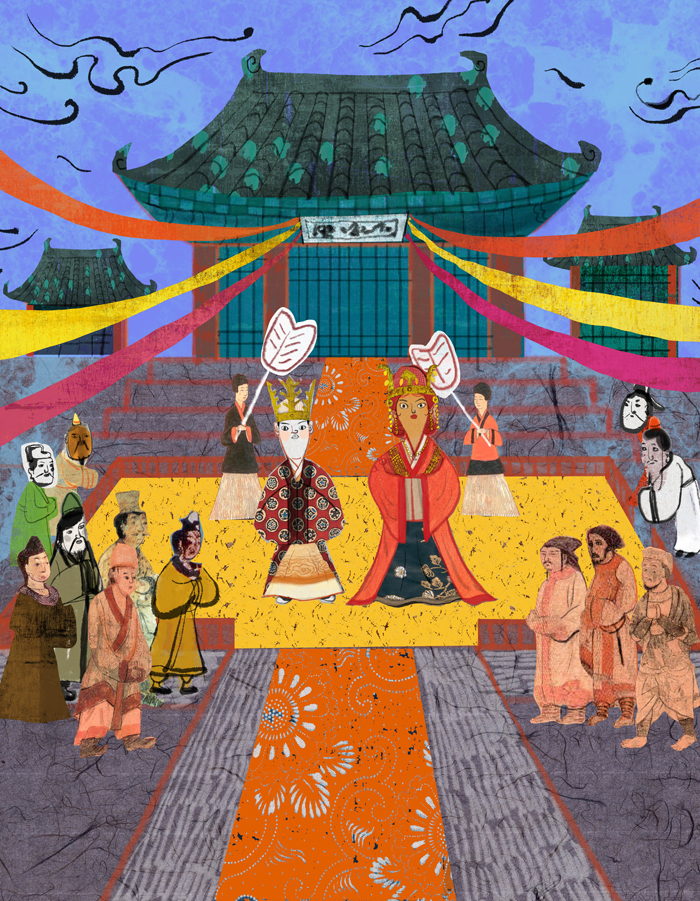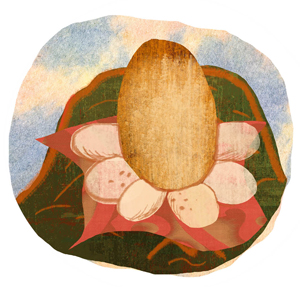View this article in another language
- 한국어
- English
- 日本語
- 中文
- العربية
- Español
- Français
- Deutsch
- Pусский
- Tiếng Việt
- Indonesian
In Gimhae, Gyeongsangnam-do, there lies the royal tomb of King Suro, the first king of Gaya. Whether the tomb is really occupied by King Suro’s corpse remains a matter of debate in academic circles, as there’s a question of whether he actually existed. Whether fact or fiction, from what’s stated in the Samgungnyusa (Memorabilia of the Three Kingdoms), King Suro is indeed a historical figure who played a significant role in Korea’s history.
The oldest reference that allows us to trace the history of King Suro and the Gaya Kingdom is the “Garakgukgi” in Samgungnyusa. “Garakgukgi” was written by a writer who was dispatched to Gimhae, which was at that time known as Geumgwan, when King Munjong ruled the Goryeo Dynasty (918–1392). The story was then summarized by a monk and was rewritten in Samgungnyusa.

The Beginning
According to “Garakgukgi,” when the world began, there were no countries, no kings, and no vassals. However, there were people and those who acted as leaders. There were nine leaders, who ruled over about 70,000 people living in 100 houses, but there was no one to call a king. So King Suro became the first king and was named so because in Chinese, su means “head,” or “first,” and ro means “to appear.”
Just a little north from King Suro’s tomb in Gimhae is Gujibong Peak, which resembles the head of a turtle. Six golden eggs in a golden box wrapped in a red cloth were said to be let down from the heaven at the top of the peak. After 12 days had passed, the eggs hatched. Surprisingly, King Suro wasn’t the only one born on that day. Six boys hatched from the golden eggs, and King Suro was one of them. Each boy became a king and ruled over other parts of the land. However, it was King Suro who first chose the land for building a capital, which he called Garak, also known as Gaya.
The Nation’s First Interracial Marriage
In July of 48 AD, a boat with a princess from the ancient Indian city of Ayodhya onboard anchored at a small harbor on the Korean Peninsula. She embarked on her journey after her royal parents had a dream that their daughter, Heo Hwang-ok, would find her husband in a small harbor in Korea. Upon Heo's arrival, the two married, and according to Samgungnyusa, their marriage was the first recorded interracial marriage on the Korean Peninsula.
Moreover, Heo was 16 when she married King Suro, who was only around six, which probably makes him the first Korean man to get married to an older woman, a trend that has recently become popular on the Korean Peninsula.

The Progenitor of the Gimhae Kims
King Suro was not only the first king of Gaya and the first Korean man to marry a foreigner but also the progenitor of the Gimhae Kim clan.
Queen Heo is said to have given birth to 10 children, the start of the powerful dynasty of the Gimhae Kim clan. Starting with King Suro, Gimhae Kims are known for having produced numerous well-known literary and martial arts statesmen. Gimhae Kims were especially influential during the Goryeo Dynasty, as there were 15 minister-level statesmen, about 10 vassals of merit, eight generals, and more. However, the only Gimhae Kim minister during the Joseon Dynasty was Kim U-hang. The surname recovered after the Japanese colonial era and again produced men of distinguished talents.
Written by Yim Seung-hye
Illustrated by Shim Soo-keun
*The series of old Korean tales has been made possible with the cooperation with Korea Magazine.
The oldest reference that allows us to trace the history of King Suro and the Gaya Kingdom is the “Garakgukgi” in Samgungnyusa. “Garakgukgi” was written by a writer who was dispatched to Gimhae, which was at that time known as Geumgwan, when King Munjong ruled the Goryeo Dynasty (918–1392). The story was then summarized by a monk and was rewritten in Samgungnyusa.

The Beginning
According to “Garakgukgi,” when the world began, there were no countries, no kings, and no vassals. However, there were people and those who acted as leaders. There were nine leaders, who ruled over about 70,000 people living in 100 houses, but there was no one to call a king. So King Suro became the first king and was named so because in Chinese, su means “head,” or “first,” and ro means “to appear.”
Just a little north from King Suro’s tomb in Gimhae is Gujibong Peak, which resembles the head of a turtle. Six golden eggs in a golden box wrapped in a red cloth were said to be let down from the heaven at the top of the peak. After 12 days had passed, the eggs hatched. Surprisingly, King Suro wasn’t the only one born on that day. Six boys hatched from the golden eggs, and King Suro was one of them. Each boy became a king and ruled over other parts of the land. However, it was King Suro who first chose the land for building a capital, which he called Garak, also known as Gaya.
The Nation’s First Interracial Marriage
In July of 48 AD, a boat with a princess from the ancient Indian city of Ayodhya onboard anchored at a small harbor on the Korean Peninsula. She embarked on her journey after her royal parents had a dream that their daughter, Heo Hwang-ok, would find her husband in a small harbor in Korea. Upon Heo's arrival, the two married, and according to Samgungnyusa, their marriage was the first recorded interracial marriage on the Korean Peninsula.
Moreover, Heo was 16 when she married King Suro, who was only around six, which probably makes him the first Korean man to get married to an older woman, a trend that has recently become popular on the Korean Peninsula.

The Progenitor of the Gimhae Kims
King Suro was not only the first king of Gaya and the first Korean man to marry a foreigner but also the progenitor of the Gimhae Kim clan.
Queen Heo is said to have given birth to 10 children, the start of the powerful dynasty of the Gimhae Kim clan. Starting with King Suro, Gimhae Kims are known for having produced numerous well-known literary and martial arts statesmen. Gimhae Kims were especially influential during the Goryeo Dynasty, as there were 15 minister-level statesmen, about 10 vassals of merit, eight generals, and more. However, the only Gimhae Kim minister during the Joseon Dynasty was Kim U-hang. The surname recovered after the Japanese colonial era and again produced men of distinguished talents.
Written by Yim Seung-hye
Illustrated by Shim Soo-keun
*The series of old Korean tales has been made possible with the cooperation with Korea Magazine.